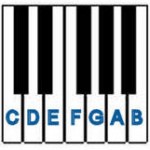I just got the guitar…now what? (part 3)
Dec 11, 2009 Guitarists, Music Theory
Posted by
Mike Mora
So, now we know all the parts of the guitar and how to tune the guitar – great…when do we get to be the next Eddie Van Halen? Well, that might take some time. Truthfully, it might take some time to get to be the next Billy Ray Cyrus. No offense to any of those Billy Ray Cyrus fans out there (it’s fine to admit that you are a BRC fan, just not to any of your guitar playing friends). Ok, let’s take some basic steps. How about some basic concepts leading us to some basic chords.
Music is a language that consists of 12 tones. These tones are A A#(or Bb) B C C#(or Db) D D#(or Eb) E F F#(or Gb) G G#(or Ab).

On a piano, this pattern repeats for the full length of the available keys.

For the purpose of getting started, let’s just concentrate on the natural notes – those are the ones without the sharps (#) or the flats (b). So the natural tones are as follows A B C D E F G.

I start with the “C” because that’s the way I learned the groupings on the piano. Yes, yes, I know…this is a guitar lesson but the theory I want write about is easiest to SEE on the piano but very applicable to the guitar. Back to the “C“, I have always remembered that the key for C is the first key to the left of the grouping of 2 black keys. This follows through on the entire keyboard. That note sounds the same at each of these positions, just at different octaves. What’s an octave? Hmmm…if you have seen “The Sound of Music” (and who hasn’t?), when the nun/governess/stepmom played by Julie Andrews teaches the children to sing, she teaches them the song “Do Re Mi”.
Now unlike the piano, I can actually play the same note in multiple places on the guitar. The important portion of this is that there is spacing between the notes, musical tones that give us the different tonalities we need to create music in different keys. So if we look back at the piano:

We can that there is a note between every natural tone except E and F. Actually, if you extend the keyboard you also see there isn’t a note between B and C either. That’s important. Why is that important? Well, this develops the musical spacing between notes. Since most people think in natural notes, the space between “most” of the natural notes was called aWHOLE STEP. This worked out great for everyone until a mathematician by the name of Pythagoras came up with this theory – Musica Universalis. Netting it out, this philosophical concept was figured out when Pythagoras began noticing different tonalities (musical moods) between different singers who sang in different ranges.
For more info, head over to Pythagoras’ Discovery
WHY DOES THIS MATTER TO ME? I’M A GUITAR PLAYER!!! Actually, that’s a valid question. Here’s the key – the frets of the guitar are spaced in half-steps. In other words, from the C note on the guitar, the next fret is a half-step from that note. Going higher (towards the body of the guitar) would make the next fret C#, going lower (towards the headstock of the guitar) would make the next fret B.
Tags: beginnings, guitar, theory
Leave a Reply